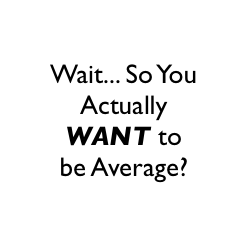 What’s the average conversion rate for free trials, pricing pages, or Freemium with SaaS or Web Apps?
What’s the average conversion rate for free trials, pricing pages, or Freemium with SaaS or Web Apps?
There are some fundamental problems with “average conversion rate” which is why people rarely like my standard answer of: “It depends” or my more direct answer of “why, so you can be average?”
Look, if you have a 1% conversion rate right now, 2% should be looking pretty darn good to you, right?
If you have a 25% conversion rate, 26% might not be that exciting. 30% might be though!
Or if you have a 25% conversion rate, maybe 5% is what we’ll shoot for because we want more cold traffic coming through and will expect a lower rate for a little bit until we figure things out, right?
The number that Joe’s SaaS company is getting vs. Claire’s Web App doesn’t matter, regardless of what the people that have surveyed 327 “SaaS” companies to get aggregate data without context want you to believe.
We don’t even know what metric companies are basing their “average conversion rate” on and we can assume most people who talk about their numbers talk about the ones that make them look good!
But, we have been trained as an industry to look to average numbers for guidance.
So let me ask you… how can looking to averages lead to anything but average results?
When we look to average numbers to plan our businesses around, aren’t we planning on being average?
Did you create your web app just to be average?
Did you go to work for Giant SaaS Co. and seek out resources like I’ve put together so you could just be average?
Here is why “average” is damaging, aside from the whole “shoot for the middle” mediocrity problem it brings with it.
Average lacks context.
If I told you the average conversion rate for Free Trials in SaaS was 10% (and I am NOT telling you that, BTW), you’d aim for that, right?
And 10% would be a nice goal if you were currently at 5% I suppose.
But if you have an 85% conversion rate, 10% just wouldn’t make sense, right?
Even worse, it could make you think you’re doing really, really good with your 85% conversion rate and could keep you from taking corrective action.
Maybe you’d just go spend a lot to get more traffic before you realize that 85% conversion rate was an anomaly based on early-adopters and doesn’t hold-up against cold, mainstream traffic.
Look, “average” is a pointless number for so many reasons, not the least of which is…. well, that it is “average.”
You see… context is usually missing which is what the folks with the 85% conversion rate that I helped out needed to know to figure out where they really stood (and it wasn’t as good as an 85% conversion rate sounds!)
Here’s the simple way to move forward.
Figure out where you are today – something most people (including you, I bet) don’t actually know – and then figure out how to make it better.
This works whether you’re a one-person, bootstrapped shop or a tiger-team w/ buckets of VC money.
Don’t worry about what others are doing.
But then again I don’t make money selling survey results so that’s easy for me to say, right?
Look, if you’re at a 1% conversion rate, let’s shoot for 2% and DOUBLE where you are today.
Remember, that is a 100% increase over what you have now…
Isn’t a 100% increase in conversion rates hard enough to do without trying to meet some number that an analyst came up with that probably doesn’t even directly apply to your business and certainly lacks context?
You can reach 2% from 1%, right? Easy.
But if you see 25% sitting in front of you as your immediate goal – because that is the average conversion rate (it is NOT!) – that might be discouraging.
On the flip side if you have an 85% conversion rate and you feel that something is off, dig in and figure out the context. A super-high conversion rate is fantastic, but only in context.
Here’s a hint… the most important “context” for most real companies is revenue.
So the next time you pull up Google, or Quora, or LinkedIn to look for “average conversion rates” stop for a second and think about what you’re doing.
Don’t be average.
By the way, I KNOW someone is going to say “Lincoln, that makes total sense. I get it for sure. But, hey, so what is a good conversion rate number to put in the business plan?”… which is why business plans are pretty much irrelevant most of the time!


